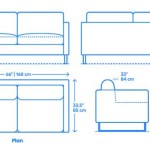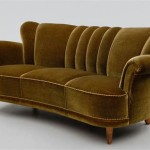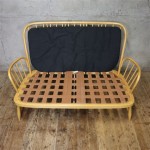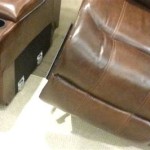How To Replace the Fabric On the Underside of a Sofa
The fabric on the underside of a sofa, often referred to as the dust cover or cambric, serves several key functions. It protects the internal components of the sofa – the springs, webbing, and frame – from dust, dirt, and pests. It also provides a finished look to the sofa's bottom, concealing the sometimes messy interior construction. Over time, this fabric can become torn, ripped, or damaged, leaving the sofa vulnerable and aesthetically unappealing. Replacing this fabric is a manageable DIY project that can extend the life of the sofa and improve its overall appearance.
This article provides a comprehensive guide to replacing the fabric on the underside of a sofa. It outlines the necessary materials, tools, and step-by-step instructions required to complete the project successfully. The process involves removing the old fabric, measuring and cutting the new fabric, and securely attaching it to the sofa frame.
Preparing for the Replacement
Before embarking on the replacement process, gather the necessary materials and tools. This preparation phase is crucial for a smooth and efficient workflow. Ensuring you have everything on hand beforehand minimizes interruptions and prevents frustration during the project.
Materials Required:
New Fabric: Choose a durable, non-woven fabric for the replacement. Cambric is a common and affordable option specifically designed for this purpose. Consider the weight and thickness of the fabric, opting for something that can withstand wear and tear. The color is primarily aesthetic, but a dark color is often preferred as it conceals dust and dirt better. The amount of fabric needed will depend on the size of the sofa's underside, so accurate measurements are essential.
Staples: Use heavy-duty staples that are appropriate for upholstery. The length of the staples should be sufficient to penetrate the fabric and securely hold it to the wooden frame without protruding excessively. Common staple sizes range from 1/4 inch to 3/8 inch, but always test the staple size on the frame to ensure it doesn’t go all the way through. Stainless steel staples are preferable because they won’t rust.
Tools Required:
Staple Remover: A staple remover is essential for efficiently removing the old staples without damaging the sofa frame. There are dedicated staple removers available, or a flat-head screwdriver and pliers can be used as alternatives.
Measuring Tape: Accurate measurements are critical for ensuring the new fabric fits properly. A flexible measuring tape is ideal for conforming to the contours of the sofa.
Scissors or Utility Knife: Use sharp scissors or a utility knife for cutting the new fabric to size. A rotary cutter can also be used for straight lines along a cutting mat.
Staple Gun: A heavy-duty staple gun is necessary for securely attaching the new fabric to the sofa frame. Manual, electric, and pneumatic staple guns are all viable options, each offering varying levels of power and ease of use.
Gloves: Wearing gloves is recommended to protect your hands during the staple removal and stapling process. This is especially important when dealing with older staples that might be rusted or sharp.
Safety Glasses: Safety glasses will protect your eyes from flying staples or debris during the removal process.
Removing the Old Fabric
The removal of the existing fabric must be done carefully to avoid damaging the sofa frame or upholstery. Proceed systematically, taking your time to ensure all staples are removed completely.
Step-by-Step Instructions:
Inspect the Existing Fabric: Before starting, carefully examine how the old fabric is attached to the sofa frame. Note the staple pattern and any areas where the fabric is particularly taut or loose. This will provide insights into how to attach the new fabric correctly.
Prepare the Work Area: Lay down a drop cloth or old sheet to protect the floor from debris. This makes cleanup easier and prevents damage to the floor surface.
Remove the Staples: Using the staple remover, carefully pry up each staple. Work systematically, starting at one corner and moving along the perimeter of the sofa. If using a flat-head screwdriver and pliers, gently lift the staple with the screwdriver and then use the pliers to pull it out completely. Be cautious not to damage the wood frame during this process.
Remove the Old Fabric: Once all the staples have been removed, carefully detach the old fabric from the sofa frame. If the fabric is stuck in certain areas, double-check for any missed staples.
Inspect the Frame: After removing the old fabric, inspect the sofa frame for any damage, such as cracks or splinters. Repair any damage before proceeding with the new fabric installation. Filling small cracks with wood filler and sanding them smooth can prevent further damage. Make sure the frame is clean of any debris.
Installing the New Fabric
The installation phase requires careful measurement, precise cutting, and secure stapling to ensure a professional-looking result. Take your time and pay attention to detail to achieve a taut and even finish.
Step-by-Step Instructions:
Measure and Cut the New Fabric: Use the measuring tape to measure the dimensions of the sofa's underside. Add a few inches to each side to allow for overlap and adjustments during the stapling process. This extra fabric provides flexibility and ensures the fabric can be stretched tautly.
Lay the new fabric on a flat surface and use the measurements to cut it to size using scissors or a utility knife. A rotary cutter and cutting mat can provide more accurate and clean cuts, especially for straight lines. Double-check the measurements before cutting to avoid mistakes.
Position the New Fabric: Center the new fabric over the underside of the sofa, ensuring that it is evenly distributed on all sides. The extra fabric should overlap the edges of the frame by a few inches.
Staple One Side: Starting at one corner, pull the fabric taut and staple it to the frame. Use the staple gun to drive the staples securely into the wood. Space the staples approximately 2-3 inches apart. Maintain consistent tension to avoid wrinkles or sagging.
Staple the Opposite Side: Move to the opposite side of the sofa and repeat the stapling process. Pull the fabric taut to remove any slack or wrinkles. This ensures that the fabric is evenly stretched across the frame. Alternate between sides to maintain even tension.
Staple the Remaining Sides: Repeat the stapling process for the remaining two sides, pulling the fabric taut and maintaining consistent tension. Pay close attention to the corners, ensuring that the fabric is neatly folded and stapled securely. Trim any excess fabric at the corners to reduce bulk.
Inspect and Adjust: Once all sides have been stapled, inspect the fabric for any wrinkles, sagging, or loose areas. If necessary, remove the staples in these areas and re-staple the fabric, adjusting the tension as needed. This ensures a smooth and professional finish.
Trim Excess Fabric: After the fabric is securely stapled, use scissors or a utility knife to trim any excess fabric along the edges. Cut close to the staple line, leaving a clean and finished edge. Be cautious not to cut into the staples or the sofa frame.
Final Inspection: Conduct a final inspection of the underside of the sofa, ensuring that all staples are securely in place and that the fabric is taut and even. Address any remaining imperfections to achieve a professional-looking result.
How To Replace Underside Fabric Of A Chair Ifixit Repair Guide
How To Replace Underside Fabric Of A Chair Ifixit Repair Guide

Cambric Dust Cover Fabric Under Chair Non Woven Nylon Bottom Of Upholstery Connection

Cambric Dust Cover Fabric Under Chair Non Woven Nylon Bottom Of Upholstery Connection

Cambric Dust Cover Fabric Under Chair Non Woven Nylon Bottom Of Upholstery Connection

How To Reupholster A Couch Without Removing The Old Fabric Erfly House

How To Reupholster A Couch Without Removing The Old Fabric Erfly House

Replacement Fabric For Underside Sofa Dust Cover Cambric Bottom Cloth New

How To Replace Two Piece Sling Chair Fabric

Xlarge Sofa Slipcover One Piece High Stretchy Couch Cover Machine Washable Spandex Jacquard Fabric Bottom Elastic Easy To Install Com








